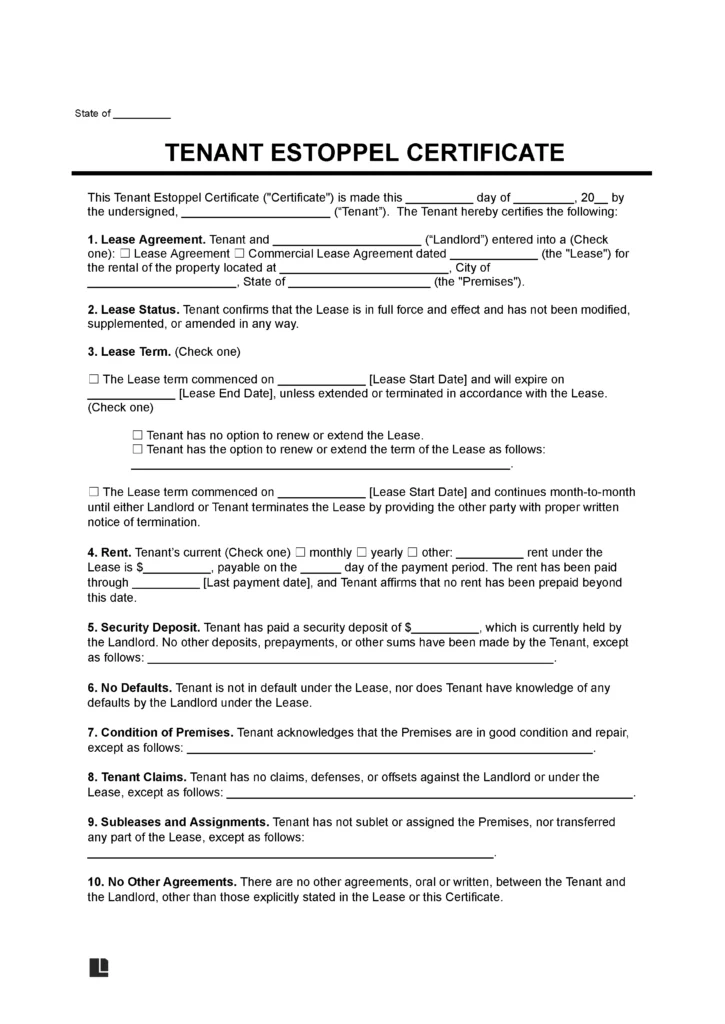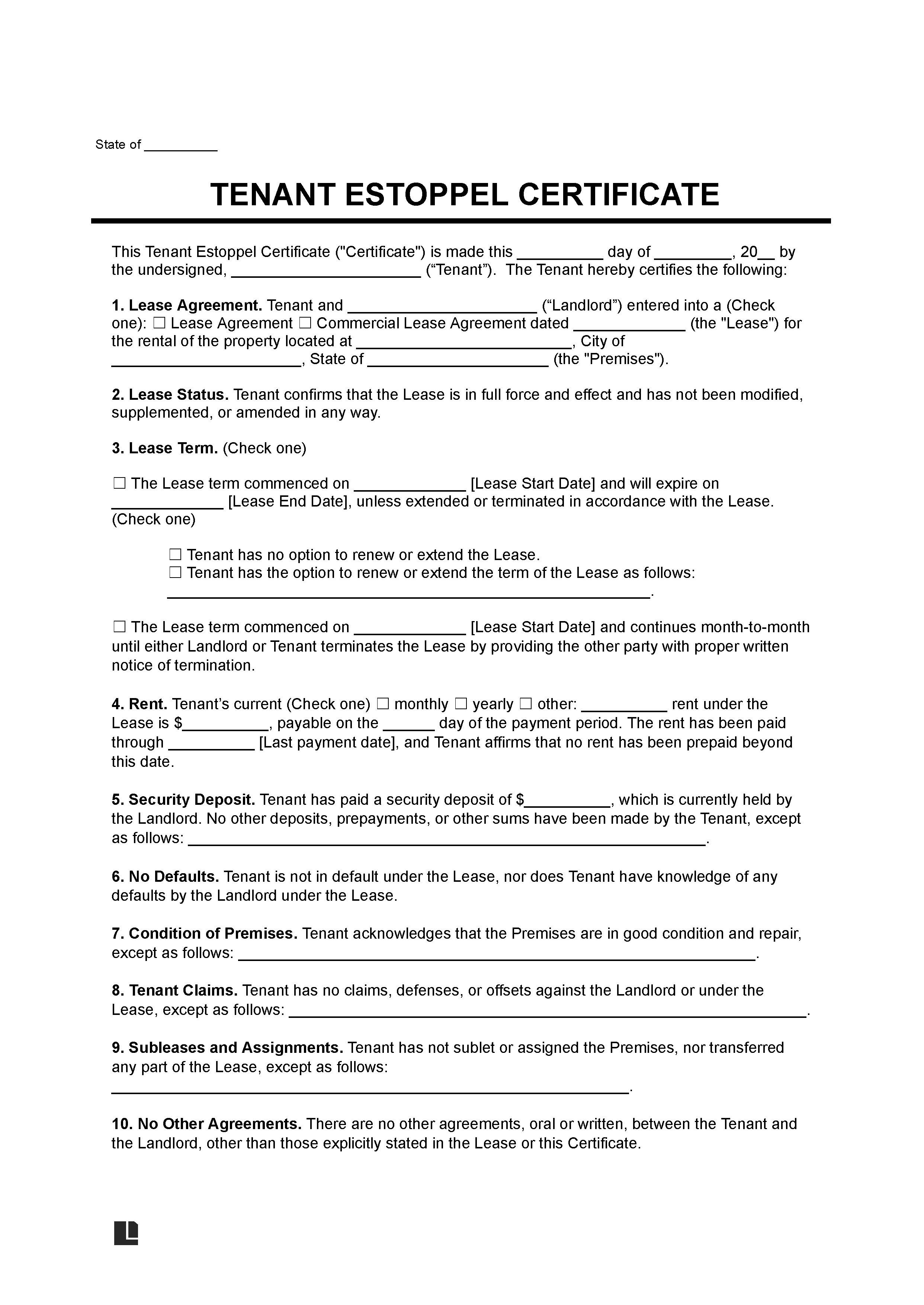A Tenant Estoppel Certificate is a document used in real estate transactions to confirm the current terms and status of a lease agreement between a landlord and tenant. This certificate is primarily used during the sale or refinancing of a property to provide potential buyers or lenders with a clear understanding of the property’s financial obligations and cash flow.
Key Functions of a Tenant Estoppel Certificate
- Verification of Lease Terms: The tenant certifies details like rent amount, lease term, security deposits, and any existing agreements not outlined in the original lease (such as side agreements related to parking spaces or storage areas).
- Binding Nature: Once signed, the estoppel certificate is legally binding. The tenant is held to the contents of the certificate, even if there are errors. For instance, if a tenant mistakenly includes incorrect lease termination dates, any party can rely on this as fact.
- Clarity for Buyers and Lenders: Buyers and lenders use estoppel certificates to confirm rental amount, check any outstanding claims or assignments, and to verify the tenant’s rights. In commercial property transactions, these certificates are crucial. It provides a third party with assurance that the lease terms are valid and accurate. In commercial real estate transactions, requiring tenant estoppel certificates is a routine process during property sales.
What’s An Estoppel All About?
- Lease Confirmation: Courts typically treat the contents of an estoppel agreement as conclusive proof of the lease’s terms. These agreements often include statements affirming that a lease exists and that the tenant is not in default. Even if the information is incorrect, tenants may not be able to contest it later, as seen in notable cases like Plaza Freeway Ltd. Partnership v. First Mountain Bank.
- Preventing Future Disputes: Tenants, especially in rent-controlled areas, need to be aware of the implications of signing an estoppel certificate. Errors or omissions could lead to disputes over rent control protections or other lease entitlements. If a tenant refuses to sign the estoppel certificate, it can result in breaches of the lease agreement, potentially leading to eviction and additional damages owed to the landlord.
- Impacts Property Sales and Refinancing: In property sales, an estoppel certificate confirms key details such as lease terms, tenant obligations, and rent payments, providing assurance to buyers that there are no hidden liabilities. For refinancing, lenders often require an estoppel to verify the financial standing of the property, ensuring the income stream is as stated.
- Side Agreements: Any verbal agreements, such as permission to have a pet or the right to sublet, should be included in the estoppel certificate to prevent future misunderstandings.
- Resolving Conflicts with the Lease Agreement: If there is a conflict between the lease agreement and the estoppel certificate, courts will often consider both documents together to resolve the ambiguity.
What To Do If You Receive a Tenant Estoppel?
Step 1 – Check the Lease
Review the original lease to determine if it requires a tenant estoppel certificate to be provided upon request. Most commercial and residential leases include this clause.
Estoppel certificates are crucial during property ownership transitions to inform the new owner of the tenant’s existing rights and obligations. This applies to both commercial and residential tenants, as the implications of these certificates are significant for all types of tenants.
Step 2 – Request the Certificate
The landlord or their representative should formally request the tenant to complete the estoppel certificate, typically in writing. The request should reference the lease provision requiring the certificate.
Step 3 – Provide Documentation
The landlord prior or their representative must provide the tenant with the estoppel certificate form, along with any necessary documentation to confirm the lease details, such as a copy of the lease or payment history.
Step 4 – Tenant’s Review
The tenant must carefully review the lease and any side agreements to ensure that the estoppel certificate accurately reflects the terms. They should include any verbal agreements that were made but not documented in the lease.
Step 5 – Notarization (Optional but Common)
In some jurisdictions or transactions, particularly where financing is involved, the estoppel certificate must be notarized to ensure its validity.
Step 6 – Return the Signed Certificate
The tenant should sign the estoppel certificate and return it to the landlord within the specified time frame (often provided in the lease, such as 10 to 30 days).
Step 7 – Consequences of Failure to Sign
If the tenant fails to sign and return the certificate, certain leases may allow the landlord to fill it out on the tenant’s behalf or penalize the tenant. Some leases even include a deeming provision whereby failure to sign implies that the tenant has accepted the document’s contents.
Essential Sections in the Estoppel Certificate
1. Parties Involved:
- Landlord’s Name and Address.
- Tenant’s Name and Address.
2. Property Description:
The address or description of the property subject to the lease.
3. Lease Information:
- Lease Start Date and End Date: This section confirms the lease duration, including any renewal periods or options.
- Rent Details: Monthly rent amount, date rent is due, and any other financial obligations (such as utility payments or maintenance fees).
- Security Deposits and Prepaid Rent: Mention any security deposit or prepaid rent held by the landlord.
4. Confirmation of Modifications:
A statement confirming whether the lease has been modified or not. If modified, it should specify the amendments.
5. Tenant’s Rights:
- Renewal or Extension Rights: Any rights the tenant has to renew or extend the lease.
- Option to Purchase: Any rights the tenant has to purchase the property.
6. Sublet or Assignment:
A statement indicating whether the tenant is subletting or assigning the lease to someone else.
7. Defaults or Violations:
Whether the tenant or landlord is in default of any lease terms. If so, the nature of the default should be described.
8. Additional Agreements:
Any verbal or written side agreements that are not part of the original lease, such as agreements about parking spaces, pet allowances, or storage areas.
9. Liens and Encumbrances:
Confirmation that there are no liens or other encumbrances related to the tenant’s leasehold interest in the property.
10. Legal Signature:
The tenant’s formal signature indicating that the information provided is accurate.
Tenant Estoppel Certificate Sample


